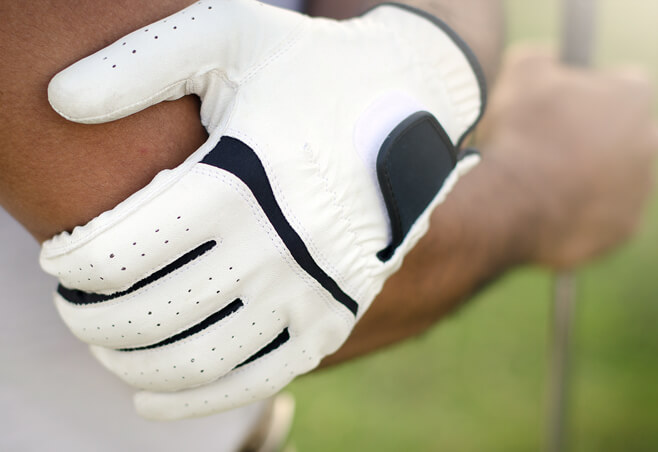Golfer's elbow
Medial epicondylitis
Like tennis elbow, golfer’s elbow involves the inner part of the elbow joint and triggers discomfort where the elbow bone connects to your forearm’s muscles. The pain may also involve your forearm.
The medical term for golfer’s elbow is medial epicondylitis. Even though it is called golfer’s elbow, the vast majority of patients treated for this condition don’t play golf or tennis. Most of the time, it is an overuse injury. Whether it be typing on the computer or repetitive activities at work, the tendons get overworked and end up with small tears, causing the pain. Other repeated activities of the elbow that can result in this condition include working an assembly line, using a hammer, an axe or any other repetitive activities that last over an hour a day.
Other sports activities may be affected by golfer’s elbow, not just golfers. For example, tennis players who constantly use their wrist and clench their fingers tightly around the racquet can be at risk.
Symptoms
The pain associated with golfer’s elbow can develop slowly or appear unexpectedly. The characteristics related to the symptoms include:
- Sensitivity on the inside of your elbow that at times may travel down your forearm (the pain may escalate during specific physical movements)
- Loss of flexibility in your elbow
- Experiencing difficulty making a fist
- Diminished strength of your wrist and hand
- Loss of feeling, or a sensation of pins and needles traveling down to your fingers
To prevent these types of overuse injuries about the elbow, try not to overuse it. If you have pain in the medial side of the elbow, or golfer’s elbow, it’s actually beneficial to work with your palm down. This transfers forces from the hand to the outside part of the elbow.
Conservative treatment methods for tennis elbow:
- Stop activities that cause the pain
- Anti-inflammatory (over the counter or prescription)
- Topical compound creams
- Physical therapy
- Cortisone shots
- Bracing

Treatment
Patients with medial epicondylitis are best treated non-operatively. The first thing is to stop the activities that cause pain. After this, anti-inflammatories can be used, either over-the-counter or prescription. Topical compound creams can be rubbed onto the area, and physical therapy can be used.
For those patients who fail the most conservative measures over roughly three months, cortisone shots or other types of injections are used. If the pain continues and all conservative methods have been exhausted after approximately a year, then possible surgical intervention may be recommended.
The surgeons at Florida Orthopaedic Institute are at the leading edge of new technologies in treating medial elbow pain. They are using other types of minimally-invasive surgical options, much like that used for cataract surgery, where the damaged tissue is removed to stimulate new healing.
If you have medial pain in the elbow, start by resting that extremity from whatever activity you’re performing. If that, combined with anti-inflammatories, doesn’t make you better, contact one of the orthopedic surgeons at Florida Orthopaedic Institute that specialize in elbow pain and treatment.
Related specialties
- Arthroscopic Debridement of the Elbow
- Aspiration of the Olecranon Bursa
- Cubital Tunnel Syndrome
- Elbow Bursitis
- Elbow Injuries & Inner Elbow Pain in Throwing Athletes
- Growth Plate Injuries of the Elbow
- Hyperextension Injury of the Elbow
- Little Leaguer's Elbow (Medial Apophysitis)
- Olecranon Stress Fractures
- Radial Tunnel Syndrome
- Tennis Elbow Treatment
- Tricep Pain & Tendonitis
- UCL (Ulnar Collateral Ligament) Injuries
- Valgus Extension Overload
